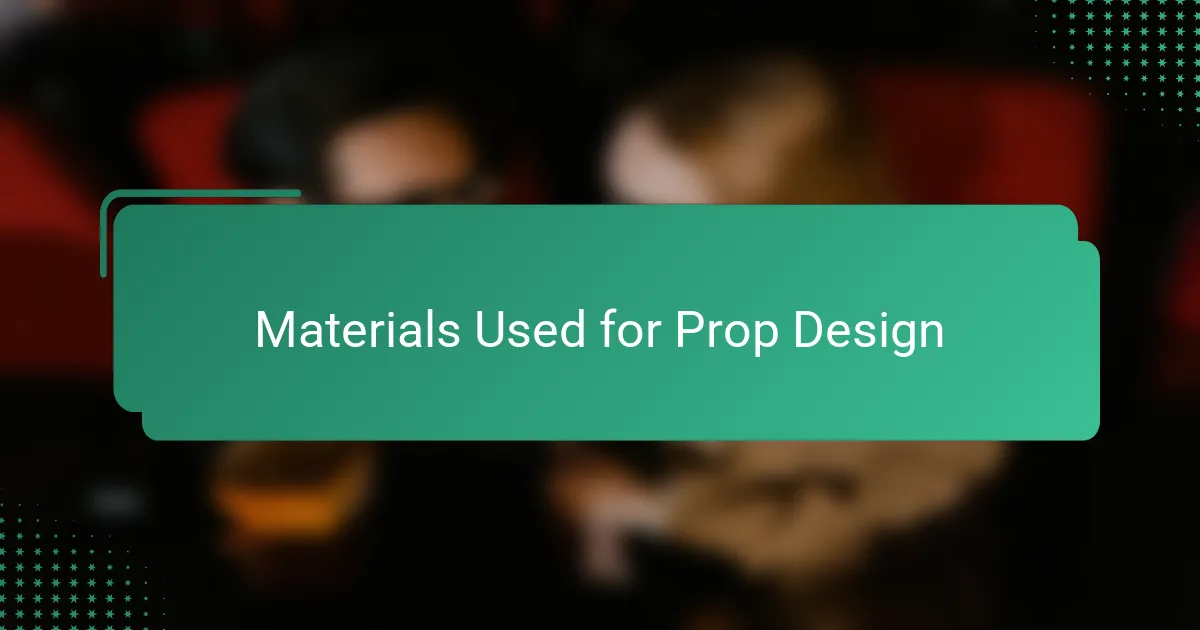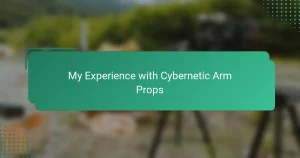Key takeaways
- Science fiction props like the Pip-Boy blend creativity and technical detail, enhancing storytelling and immersing users in fictional worlds.
- The Pip-Boy’s design features functional elements such as buttons and screens, enhancing its believability as a post-apocalyptic tool.
- Durability and authenticity are crucial in prop design, utilizing materials like plastics, resin, and techniques like 3D printing for intricate details.
- Effective display techniques, such as using stands or mannequins and proper lighting, can significantly elevate the presence and storytelling aspect of a prop.

What Are Science Fiction Props
Science fiction props are the physical objects that bring imagined worlds and futuristic technologies to life. When I first held a replica prop, I was amazed by how something so tangible could instantly transport me into a story’s universe. Have you ever wondered how a simple gadget can make fiction feel real?
These props often blend creativity with technical detail, demanding both artistic flair and practical know-how. From sleek gadgets to rugged gear, they help tell stories that words alone might struggle to convey. In my experience, the best science fiction props are those that spark curiosity and invite you to explore a world beyond your own.
What makes science fiction props truly fascinating is their ability to embody concepts that don’t exist—yet still appear believable. Crafting them is like building a bridge between imagination and reality, a challenge I find endlessly rewarding. It’s this magical mix that keeps me drawn to designing and collecting these unique pieces.

Key Features of Fallout Pip-Boy
One thing that really stood out to me about the Pip-Boy’s design is how it perfectly balances functionality with a rugged, retro-futuristic flair. Its rotating screen and numerous buttons aren’t just for show—they mimic a real, working device, making you feel like you’re holding a piece of post-apocalyptic survival gear. Have you ever held something that feels so authentic it almost becomes an extension of your arm? That’s exactly the effect I wanted to capture.
Another key feature is the way the Pip-Boy’s illuminated display reacts dynamically, giving the wearer immediate access to stats, maps, and inventory info. From my experience, this interactive element transforms it from a simple prop into a believable tool, deepening the immersion in the Fallout world. It’s fascinating how a small device can tell such a rich story all on its own.
I also appreciate the gritty texture and weathered look that defines the Pip-Boy’s aesthetic. Years of gameplay and fan feedback taught me that tiny details—like scratches, worn paint, and scuffed edges—make a world of difference in conveying history and use. It’s those imperfections that turn a cool gadget into a cherished artifact, inviting you to imagine the adventures it’s been through.

Materials Used for Prop Design
When I started gathering materials for the Pip-Boy, I knew durability and authenticity had to come first. I opted for a mix of lightweight plastics and resin—a combo that’s sturdy enough to hold its shape but still comfortable to wear for hours. Have you ever noticed how the right material can make a prop not just look real, but feel real in your hands? That tactile connection is crucial in my experience.
To achieve the detailed buttons and switches, I incorporated 3D-printed elements alongside hand-crafted parts. Using 3D printing allowed me to recreate the intricate textures and tiny features accurately, something that would have been tough with traditional methods alone. I remember how satisfying it was to see each piece slot seamlessly into place, adding that mechanical charm I was aiming for.
For the finishing touches, weathering techniques called for layers of matte paints and subtle washes to build up the signature worn-out look. I’ve always found that these materials don’t just add realism—they tell a story. When I apply a slightly chipped paint or a scuffed edge, I imagine the countless battles and journeys this worn device might have survived. Doesn’t giving a prop that history make it feel more alive? To me, that’s where the magic really happens.

Designing the Fallout Pip-Boy Model
Designing the Fallout Pip-Boy model was a journey of balancing precision with creativity. I recall spending hours sketching and refining the shape to capture that iconic bulky wrist presence—something that looks functional yet unmistakably retro. Have you ever tried to replicate a device that exists only in a game? It’s a challenge that really tests your attention to detail.
One of the trickiest parts for me was figuring out how to include all those buttons, dials, and screens without overcrowding the design. My goal was to make each element feel purposeful, as if pressing a switch would actually trigger something important. I found myself imagining the device’s user, wondering how they’d interact with it under post-apocalyptic pressure.
To bring the model to life, I combined digital tools with hands-on crafting. Using software to map out dimensions gave me a solid foundation, but it was the tactile process—cutting, assembling, and tweaking—that truly shaped the final piece. That hands-on time is where you really connect with the prop, making it not just a replica but a wearable piece of storytelling.

Building the Pip-Boy Step by Step
Starting the build, I first focused on creating a stable base for the Pip-Boy. I remember cutting and shaping the wristband frame with precision, ensuring it would not only fit comfortably but also feel solid and authentic. Have you ever realized how something as simple as a well-fitting strap can completely change the experience of wearing a prop? That initial foundation really set the tone for the entire project.
Next came assembling the detailed control panel—buttons, knobs, and that iconic rotating screen. It was a painstaking process, adjusting each piece just right so they clicked and moved realistically. From my perspective, this step is where the Pip-Boy truly comes alive because these little mechanical details invite interaction and fuel imagination.
Finally, layering on the weathered paint and subtle distressing gave the build its character. Applying those worn edges and chipped spots felt like telling a silent story of survival and adventure. Isn’t it amazing how adding a few imperfections makes the piece feel lived-in and genuine? To me, that’s when a prop stops being just an object and becomes a portal to another world.

Painting and Finishing Techniques
Painting the Pip-Boy was where the character truly surfaced for me. I chose a base coat of muted olive green to mimic that military vibe, but the real fun began with layering washes of darker shades to simulate grime and wear. Have you ever noticed how subtle variations in paint can suggest years of use without a word? That’s the kind of detail that makes a prop feel like it holds stories.
For the metallic surfaces, I mixed a bit of silver with black paint to achieve a worn steel effect, lightly dry brushing edges to highlight where friction would naturally occur. I remember stepping back and realizing those tiny scuffs and scratches weren’t just decoration—they were the prop’s battle scars, giving it a voice of experience. Isn’t it fascinating how imperfections breathe life into art?
To seal everything, I applied matte and satin varnishes selectively, balancing between the Pip-Boy’s ruggedness and its functional tech vibe. This final finish not only protected my work but also helped keep reflections in check, so the prop looked authentic under different lights. In my experience, the finishing touches are what turn a good paint job into a believable piece you actually want to wear.

Tips for Displaying the Pip-Boy Prop
Displaying the Pip-Boy prop in a way that highlights its character can really enhance its impact. I found that using a simple stand, angled just so, allows the key features—like the screen and buttons—to catch the light and invite close inspection. Have you ever noticed how the right lighting can turn a static piece into something almost alive? That subtle glow brings out the weathered textures and draws people in.
I’ve also had great success mounting mine on a wrist-shaped mannequin arm. It mimics how the Pip-Boy fits snugly around a real wrist and gives an immediate sense of scale and presence. Setting it up this way not only showcases the prop’s bulky retro-futuristic design but also sparks the imagination—making you wonder about the stories behind those scuffed edges.
Finally, don’t underestimate the power of context. Placing the Pip-Boy prop alongside related Fallout memorabilia or on a weathered surface enhances its backstory without saying a word. In my experience, these thoughtful display choices turn the prop from a mere object into a storyteller, inviting everyone who sees it to step briefly into another world.


